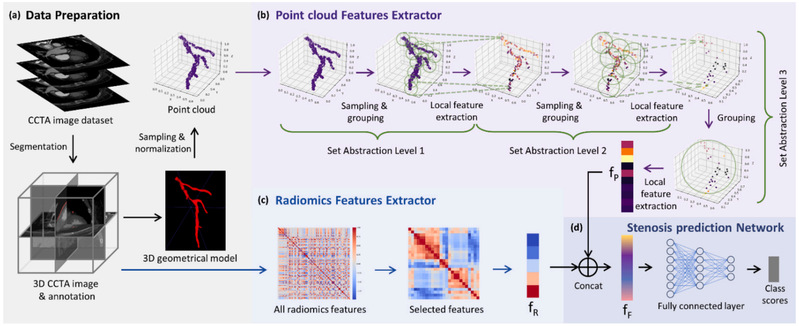

CoroPCRNet: Integrative prediction of hemodynamically significant coronary stenosis by fusing point cloud network and radiomics feature
Journal of Biomechanical (IF=2.4)
Abstract
Coronary computed tomography angiography (CCTA) has emerged as powerful tool for non-invasive screening of coronary artery disease. However, accurately assessing the hemodynamic significance of coronary artery stenosis remains a clinical challenge. This study aimed to develop a novel predictive model for accurately identifying hemodynamically significant coronary stenosis by integrating features extracted from CCTA using point cloud neural network and radiomics. This single-center retrospective study included 357 coronary artery branches from 197 patients. Point cloud datasets of coronary arteries were generated from manually segmented CCTA images, and their 3D point cloud geometric features were extracted using a point cloud neural network. Concurrently, vascular radiomics features were derived from the same segmented vascular regions. A fusion model integrating both feature sets was subsequently constructed and its performance was compared against unimodal models using only point cloud or radiomic features. Evaluated using four-fold cross-validation and an independent test set, the fusion model demonstrated the most robust predictive performance. It achieved an Area Under the Curve (AUC) of 0.822 ± 0.111 on the validation set and 0.761 ± 0.092 on the test set. In comparison, the unimodal models exhibited lower performance. The point-cloud-only model yielded AUCs of 0.786 ± 0.133 and 0.746 ± 0.075, and the radiomics-only model attained AUCs of 0.719 ± 0.128 and 0.749 ± 0.024 on the validation and test set, respectively. The proposed model fusing point cloud and radiomics features can effectively enhance the prediction of hemodynamically significant coronary stenosis. By integrating the macroscopic geometric morphology (point cloud) with microscopic image textures (radiomics), the model provides a more precise and reliable novel method for the non-invasive assessment of coronary artery stenosis.
